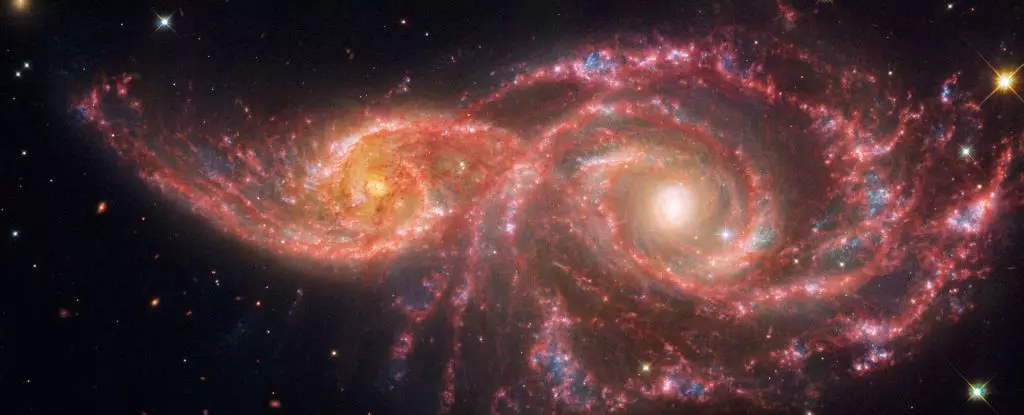In Friedrich Nietzsche’s exploration of darkness and introspection, he warned of the dangers hidden within the abyss. As we stand at the precipice of universal vastness, contemplating our place in the cosmos, we find ourselves drawn to an extraordinary spectacle—two galaxies, NGC 2207 and IC 2163, engaged in a dramatic celestial waltz approximately 80 million light-years away. How strange, that Nietzsche’s philosophical musing resonates so profoundly with this cosmic event; it serves as a reminder of not only our insignificance but also how intimately our fate may be woven into that of the universe.
The term “abyss” in Nietzsche’s context refers to a deep dive into the human psyche or existential dread. The abyss we observe through the lenses of the Hubble and James Webb Space Telescopes is far more tangible and grandiose than contemplations of self; it is a cosmic montage of creation and destruction, akin to an eternal ballet where the dancers are galaxies themselves.
What we witness in this stellar tableau is not merely a collision but a protracted dance that defies our terrestrial understanding of time and permanence. NGC 2207 and IC 2163 have engaged in interactions over millions of years, undergoing transformations with each encounter, reshaping their intricate spiral structures. The cosmic ballet is graceful yet undeniably violent, illustrating how the universe orchestrates its creations through gravitational pulls and violent mergers.
Currently engaged in a gravitational embrace, both galaxies shroud themselves in an intricate luminous display caused by the colossal forces at play. Their interactions ignite a chain reaction of star formation at an astonishing pace—dozens of solar masses birthed every year, an ordered chaos that dwarfs the star formation rate observed within our own Milky Way. It becomes evident that, within the vastness, there exists an energetic ballet where every pirouette and dip leads to the emergence of new stars, nurturing the endless lifecycle of cosmic matter.
The continual birth of stars is intricately linked with their inevitable demise; this universal cycle can be both beautiful and tragic. The lifecycle of a star is fueled by the compression of interstellar gas driven by mutual gravitational attraction, leading to stellar formations in densely packed clusters. However, the collapse of these massive stars culminates in catastrophic supernova explosions, which further compress and shock the surrounding gas, continuing the cycle of stellar birth.
The vivid colors captured in images from Hubble and JWST reveal breathtaking regions of new stars glowing in bright hues, while the dust clouds depicted in stunning detail by JWST add an ethereal quality to the event. These cosmic dust filaments weave through the galaxies like threads in a tapestry, binding together millions of years of stellar history intermingled with moments of fiery rebirth.
A Broader Perspective on Our Place in the Universe
As we reflect upon the merging dance of NGC 2207 and IC 2163, it’s difficult to overlook the philosophical implications of such celestial events. The collision serves as a reminder of the transient nature of existence. Each star that is born will eventually die, yet the cosmic chaos sparks ongoing creation—an endless cycle that mirrors Nietzsche’s musings on existence.
Perhaps this picturesque encounter also carries a valuable lesson: rather than gazing into the abyss as a metaphor for despair and futility, we should embrace these cosmic events as a manifestation of the universe’s intricate and dynamic nature. The intertwining of galaxies speaks to a shared experience much larger than ourselves—one filled with violence, beauty, and an unyielding drive toward creation.
In closing, our relationship with the cosmos is not one of mere observation; it is a part of an ever-unfolding story where every moment is crucial. As we contemplate the grandeur of NGC 2207 and IC 2163, we witness not just a celestial occurrence but also a narrative of renewal, reaffirming our connection to the expansive universe, and dare we say—every abyss we gaze into reflects back our shared journey through time and space.

